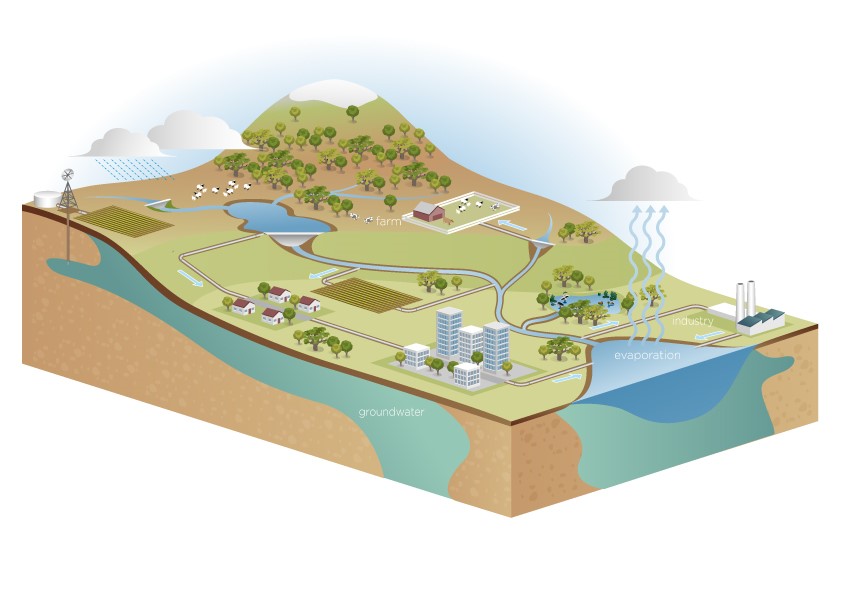A platform for truly Integrated Water Resource Management
Source is a national platform, designed for all areas of water management. As a daily time-step model with planning, operations and forecasting modes, it can be used for all aspects of water resource management, including:
- water balance studies from catchment to river basin scale
- analysis of supply and demand balances, including agricultural, hydropower, urban, industrial and environmental demands
- water quality analysis based on catchment land-use scenarios
- reservoir and river operations, encompassing low to high flow events, salt loads and system optimisation
- urban water system planning, operations and optimisation, including analysis of different supply options (reservoir/recycling/desalination)
- groundwater-surface interactions.

Developed to manage water scarcity on the driest continent on Earth
Source has been specifically designed to deal with the substantial variations Australia experiences in water availability.
For instance, the ability for planners to incorporate water governance arrangements within the platform allows them to test different policies and management options, resulting in water sharing methods and operating rules that can deal with variability.
In operations mode, the daily time-step allows operators to make decisions with almost real-time information, vital when managing low flows, where every drop of water counts.
Flexible and adaptable
Source is not a single hydrological model. It is a modelling platform, that incorporates a range of models and tools into a unique, flexible and adaptable environment that recognises the practical, technical and political issues in developing water policy.
The open software architecture of Source means you can add new capabilities, specific local needs or the latest research via tailored plug-ins. For example, the Western Australian Government has developed a plug-in for the implementation of regulations related to managing the impact of farm dams on catchment water quality and quantity.
Open architecture also allows users to incorporate existing water management models, saving time and preventing duplication. For example, Source now has a plug-in has been developed to connect to continuous rainfall-runoff models built with GR4H.
The Source community are actively and enhancing to incorporate new functionality or meet new requirements. Many Source plug-ins are freely available through a shared plug-in repository.
Scaleable
Source allows for models to be as simple or complex as the data allows or the users’ needs require.
Source operates through a high-level graphical interface, more like a manager’s “workbench” or “dashboard” than a traditional hydrologic or hydraulic model. The interface is deceptively simple. It begins with a schematic perspective of the catchment or river system, which you build simply by dragging icons from a palette to create a conceptual view.
At this high-level scale, sit allows you to quickly and easily explore the practical way a catchment or river system functions, without significant data requirements. From this starting point, you can build more sophisticated models by adding further model elements, such as rainfall-runoff, pollutant export, sediment/nutrient retention and link routing. The user can continue to select pieces from a wide range of alternatives and assign globally or by individual computational unit within the entire model domain.
Supports scenario analysis and decision making
Water is a finite resource. Governments and water agencies in most parts of the world need to make tough decisions on the best way to use the available water and balance the needs of different water users, such as irrigation, industrial, urban, hydropower and environmental demands.
Source provides a transparent and repeatable process to compare different scenarios against a baseline or each other, to show the advantages, disadvantages and trade-offs between different options.
Scenarios can include such things as:
- different management actions, for example, infrastructure size or type
- policy options, such as alternative water sharing arrangements or priorities for use
- environmental conditions, for example minimum or maximum flow requirements
- range of climate change forecasts.
Results can be shared with diverse stakeholders, such as water and catchment managers, politicians, investors and the public, to either help make the decision or understand the reasons behind a decision.
Incorporates governance
Source has the unique ability to incorporate water governance requirements, such as water allocation policies, operating rules, legal agreements and international treaties. Source can assign water to different owners, which could be a state, country or type of entitlement (such as environment, irrigation, town) and track water use. Specialised reporting and assessment functions allow you to create a water budget by water source or entitlement type.
Note: governance capability is only available in the full version of Source.
Access to training, support and a community of practice
We provide solutions-based training programs that cater from the beginner to expert Source user. Training programs can be delivered face to face or online, in either a standard format or customised to meet an individual or organisations needs.
We offer a range of support packages, giving you direct access to our experienced team of software developers and hydrologists. As well as access to a host of online resources to help you get the most out of the platform.
As Australia’s National Hydrology Modelling Platform, Source has an established Community of Practice that fosters conversation, knowledge sharing and collaboration on all things related to Source and water modelling more broadly. We welcome Source users from Australia and around the world to our annual software conference.
